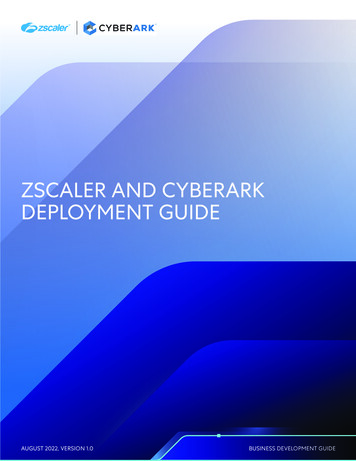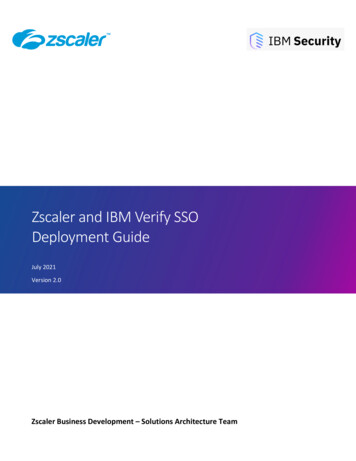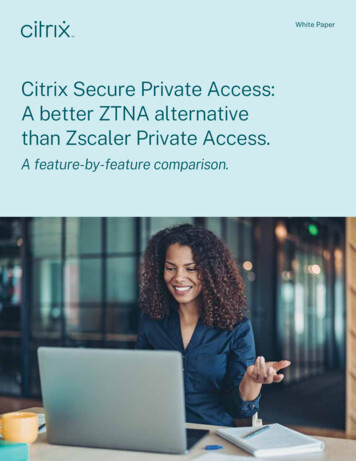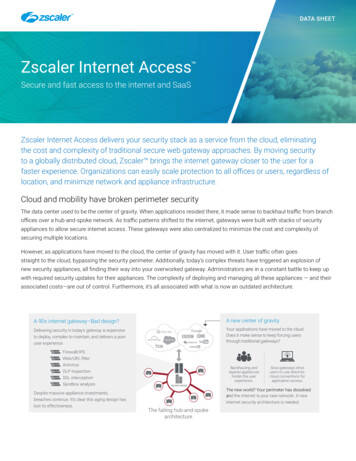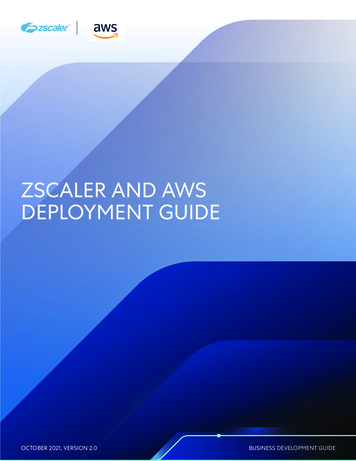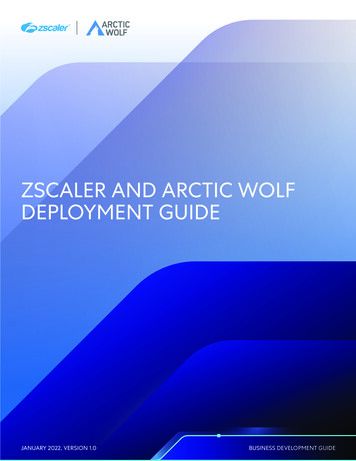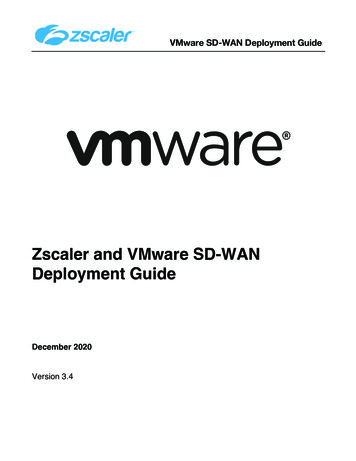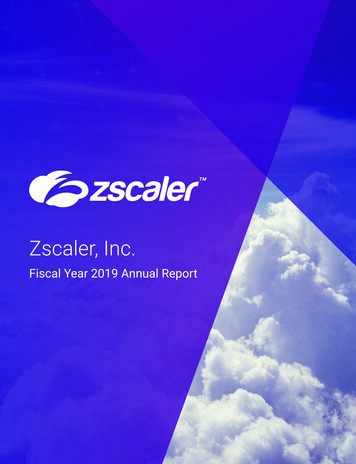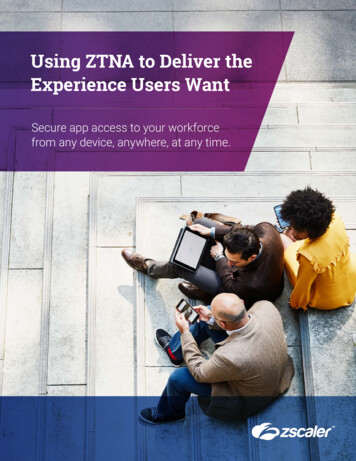
Transcription
Using ZTNA to Deliver theExperience Users WantSecure app access to your workforcefrom any device, anywhere, at any time.
USING ZTNA TO DELIVER THE EXPERIENCE USERS WANT“We want people to not have to think about how they will getaccess to their apps, and we want to support that capabilityquickly with as little friction as possible.”- Mike Towers, CSO atYour user-base has evolvedIt’s 2020 and your workforce is no longer confined to the office. They are working from home, fromhotels, and from airports. The devices they use are no longer managed BlackBerry devices given tothem by the endpoint team. They are personal BYOD smartphones, tablets, and laptops used for bothleisure and work.You are responsible for not only securing your employees, but also third-party contractors who are onthe company’s payroll as well. All of these users need identical access to private apps acrossall devices, locations and application types. Providing access from these devices, withoutcompromising security was at one point an impossibility. Not anymore.A look at your portfolio of usersWith a diversified workforce that is now globally distributed: providing secure access to privateapplications has become a challenge for IT teams. While the workforce may look different than it did15 years ago, there is still something they have in common, all your users need fast, reliable accessto private applications to keep the business running smoothly. Your modern workforce may looksomething like this:2
USING ZTNA TO DELIVER THE EXPERIENCE USERS WANTThe TravelerSam Davis, VP of Sales“I’m probably on the road about 75% of the time. More often than not, I’m in anairport, hotel, or customer site trying to get work done in the waiting periods.While my work setting may be constantly changing, I still need access to ourbusiness resources quickly so I can better serve our customers.”The LocalDanielle Allen, Finance Manager“I’m based in our HQ in San Jose, California and am, for the most partan “in office” employee. I receive requests daily from other employeesasking about their payments. I am constantly using our financeapplications and need to access them quickly so I can stay on top ofthe requests.”The ContractorElaina Thalin, Web Development Contractor“I’ve been on contract with the company for about 8-months now. WhileI’m not an employee or located in the office, I still need access to a fewprivate applications in order to get my work done. If I can’t access themthen I really can’t do my job.”The WFH-erJustin Miller, Marketing Manager“I live in Florida and am often impacted by weather warnings, includinghurricanes. In those times, I’ve needed to ensure the safety of myself andmy family while still upholding my work responsibilities.”Regardless of user type or job function, your workforce still needs to be able to access your privateapplications quickly and securely wherever they may be. IT needs to be empowered with the righttechnology to make this possible and ensure security isn’t working against user productivity. This is whyVPN isn’t a match for the modern workforce.3
USING ZTNA TO DELIVER THE EXPERIENCE USERS WANTYour users deserve better than VPNBecause VPN was developed over 30-years ago, they are no longer adequate for use with today’smodern workforce, as their flawed security design delivers a poor user experience.High latency, limited scale and poor experienceVPNs were designed to secure access to the network. This means that all user trafficis backhauled first to the datacenter, even if apps now run in public cloud. This causesnetwork tromboning, which in turn creates latency for users. Also, the VPN applianceshave user capacity limitations and can boil over if too many concurrent users areaccessing the VPN server at once.Repetitive logins and dropped connectionsEvery time there is a network change or inactivity, the VPN connection drops. For a nowmobile workforce this can happen quite frequently which results in user frustration andloss of productivity.Confusion on when to use VPN Or notOften times your users may not even know what the difference is betweenyour public and private applications. Now with applications moving to cloud, there iseven more confusion for the user knowing when, where, and how they should be usingVPN. Needless to say, VPN is not seamless or intuitive for your users.Just as Netflix could not have been built by connecting thousands of DVD players, privateapplication access solutions for anywhere, anytime access must be purpose-built. They must bealways available, highly scalable and user-centric. Retrofitting VPN appliances in the datacenter,virtualizing them, or placing them in the cloud, will not solve the user experience or networksecurity related challenges that a mobile world creates. A new approach is needed.4
USING ZTNA TO DELIVER THE EXPERIENCE USERS WANT“By 2023, 60% of enterprises will phase out most of their remoteaccess virtual private networks (VPNs) in favor of ZTNA.”Gartner, Market Guide for Zero Trust Network AccessSteve Riley, Neil MacDonald, Lawrence Orans, April 2019Ensuring users are productive with ZTNAWhether accessing SAP in the public cloud, an SSH, RDP, custom intranet, or web-based timesheetapp, the user experience should always be seamless. This is why Gartner recommends organizationsadopt zero trust network access (ZTNA) technologies as a replacement for remote access VPN.In most cases, ZTNA services are cloud-hosted and use policies to determine which authorized usersget access to a specific private application. These polices take into consideration the identity of theuser, their group, device posture and several other criteria.Since many ZTNA services are fully cloud delivered, they allow users to connect to one of theservice’s many global points of presence, which then brokers the secure connection to a privateapplication. This provides greater availability and far more scale than a VPN appliance. Users arenever placed on the network, so traffic is no longer backhauled to a datacenter. This means thatZTNA service makes access seamless to the end-user while still empowering you to minimize risk toyour business.Zero trust network access (ZTNA) architectureData Center1 Zscaler App or Browser Access1. Redirects traffic to IDP provider for authentication Client Connector automatically routes traffic toPublic Service Edge Browser Access removes need for client ondevice when accessing web-based applications3App Connector2 ZPA Public Service Edge2.2ZPA Public Service Edge1TLSUser deviceZscaler App orBrowser Access Secures the user-to-app connection Enforces all customized admin policies3 App Connector3. Sits in front of private applications in the cloudand/or data center Only responds to requests from ZPA PublicService Edge No inbound connections. Responds withinside-out connections onlyBYODdevice5
USING ZTNA TO DELIVER THE EXPERIENCE USERS WANTStart delivering the experience users wantAs you look to enable your users to be productive, consider a ZTNA service.Be sure to check out how Steve Day, EGM of Infrastructure, Cloud and Workplace at NationalAustralia Bank, enabled his users to be productive.Watch National Australia Bank’s Story play-circleWhat’s next? Take our ZTNA service for a test drive.Start a 7-day ZTNA Demo power-offAbout ZscalerZscaler enables the world’s leading organizations to securely transform their networks and applications for a mobile and cloudfirst world. Its flagship services, Zscaler Internet Access and Zscaler Private Access , create fast, secure connections betweenusers and applications, regardless of device, location, or network. Zscaler services are 100% cloud delivered and offer thesimplicity, enhanced security, and improved user experience that traditional appliances or hybrid solutions are unable to match.Used in more than 185 countries, Zscaler operates a multi-tenant, distributed cloud security platform that protects thousands ofcustomers from cyberattacks and data loss. Learn more at zscaler.com or follow us on Twitter @zscaler.Zscaler, Inc. 2020 Zscaler, Inc. All rights reserved. Zscaler , Direct-to-Cloud , ZPA , ByteScan , PageRisk , Nanolog , PolicyNow , and The Internetis the new network are trademarks or registered trademarks of Zscaler, Inc. in the United States and/or other countries. All other trademarks arethe properties of their respective owners. This product may be subject to one or more U.S. or non-U.S. patents listed at www.zscaler.com/patents120 Holger WaySan Jose, CA 95134 1 408.533.0288www.zscaler.com
About Zscaler Zscaler enables the world's leading organizations to securely transform their networks and applications for a mobile and cloud-first world. Its flagship services, Zscaler Internet Access and Zscaler Private Access , create fast, secure connections between users and applications, regardless of device, location, or network.


